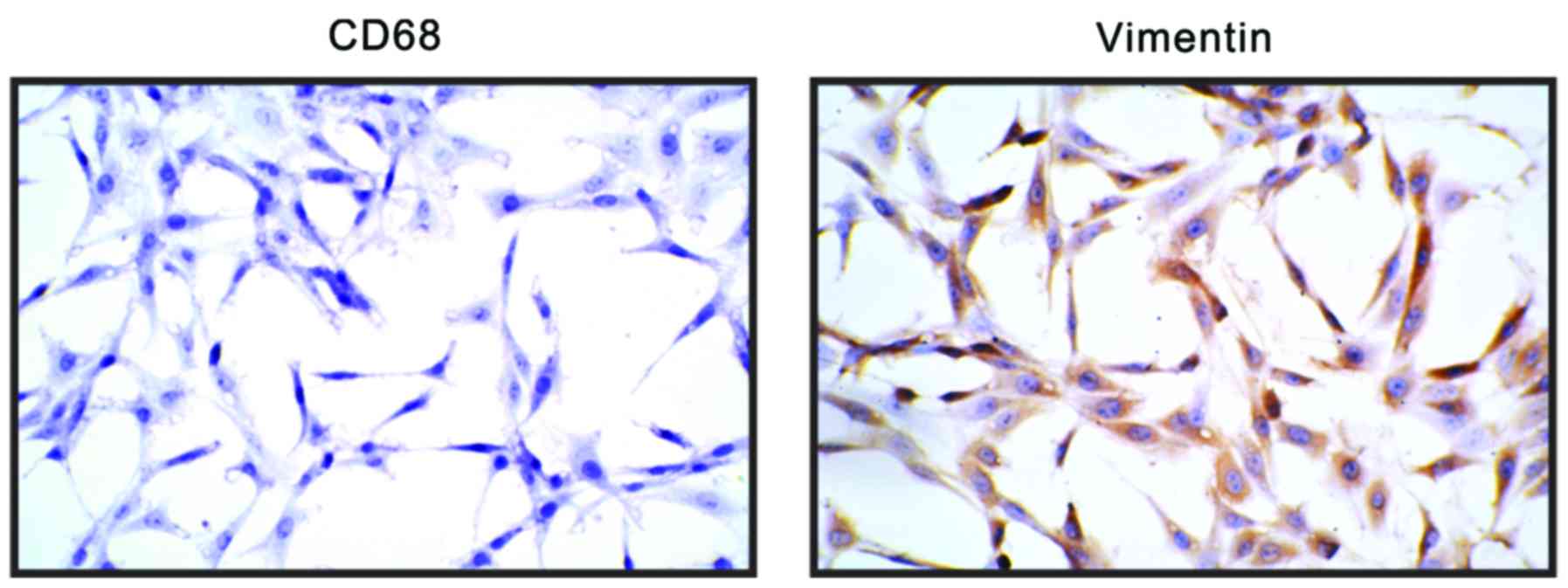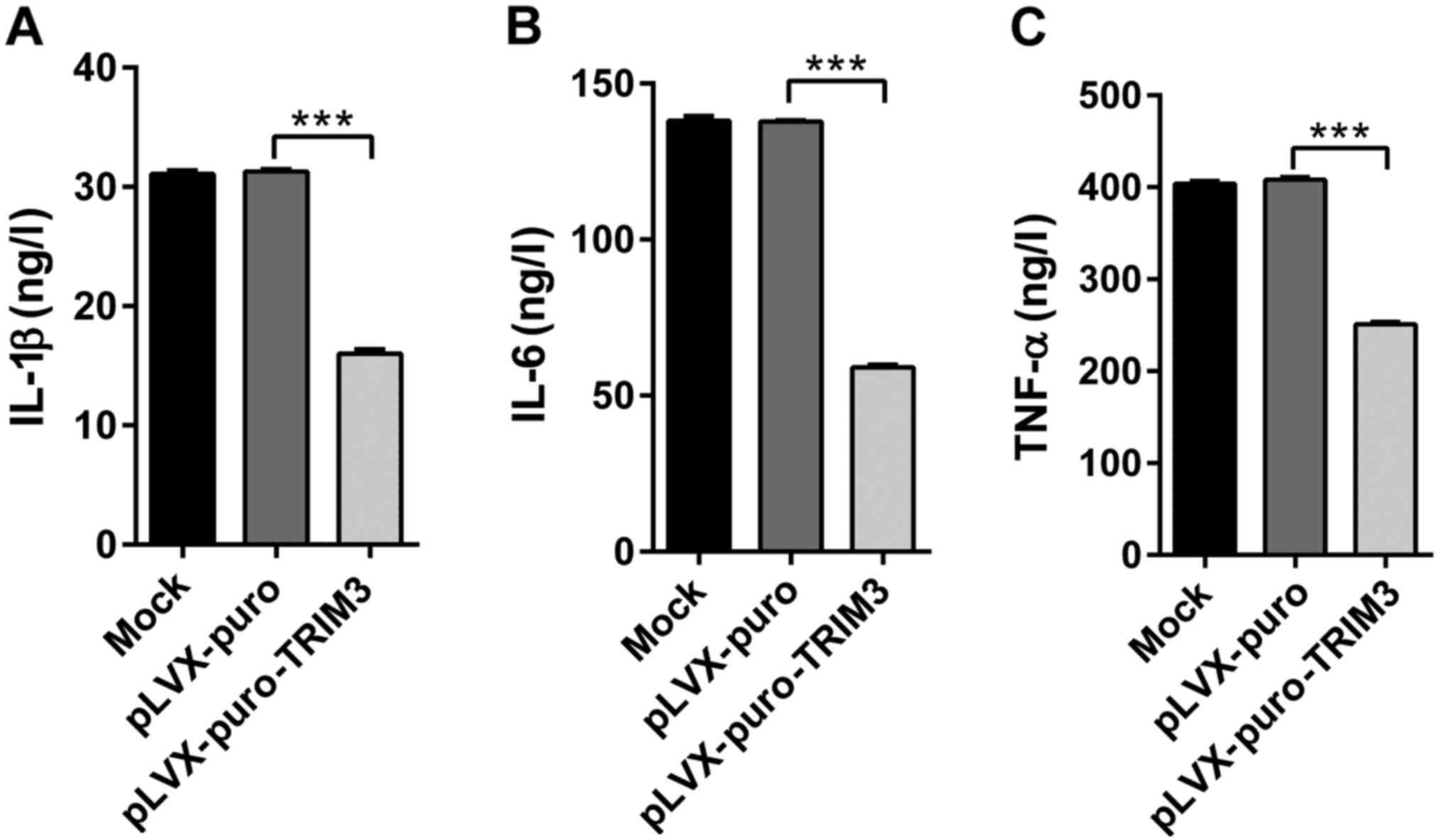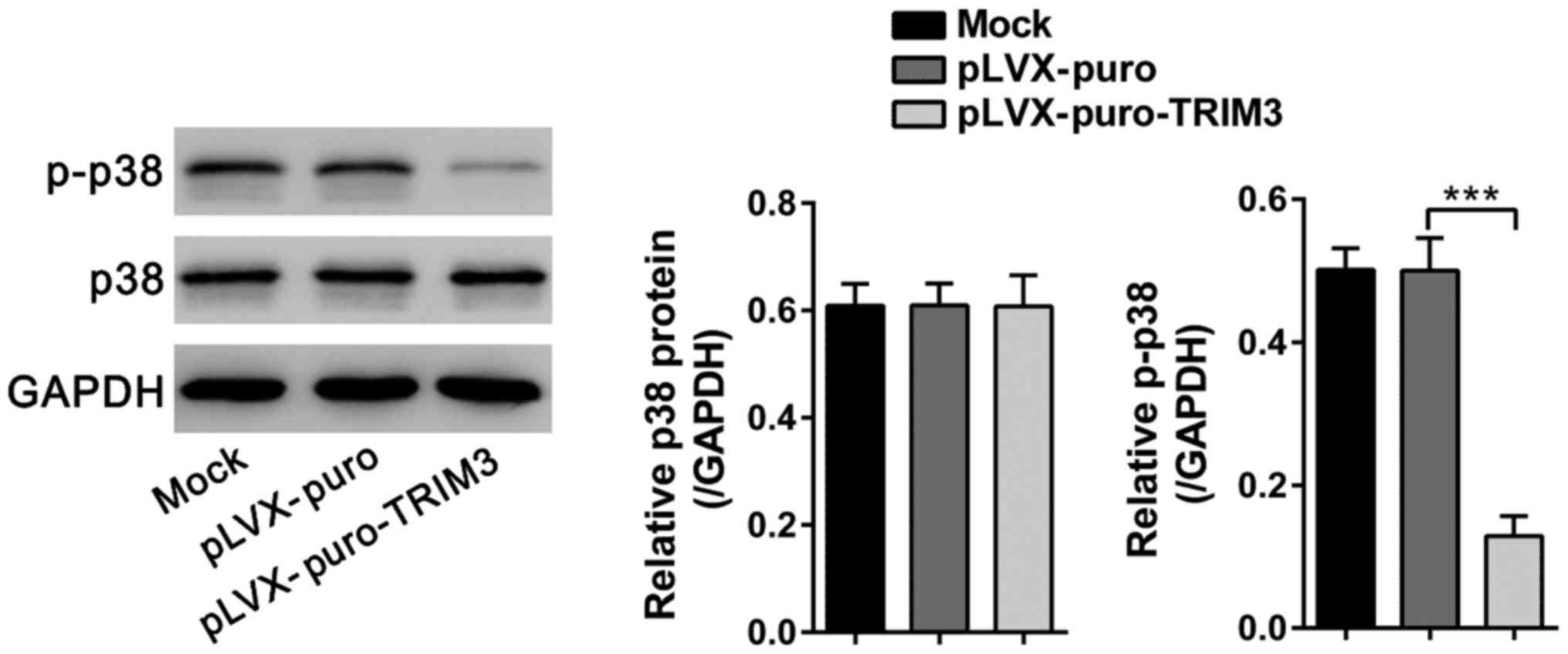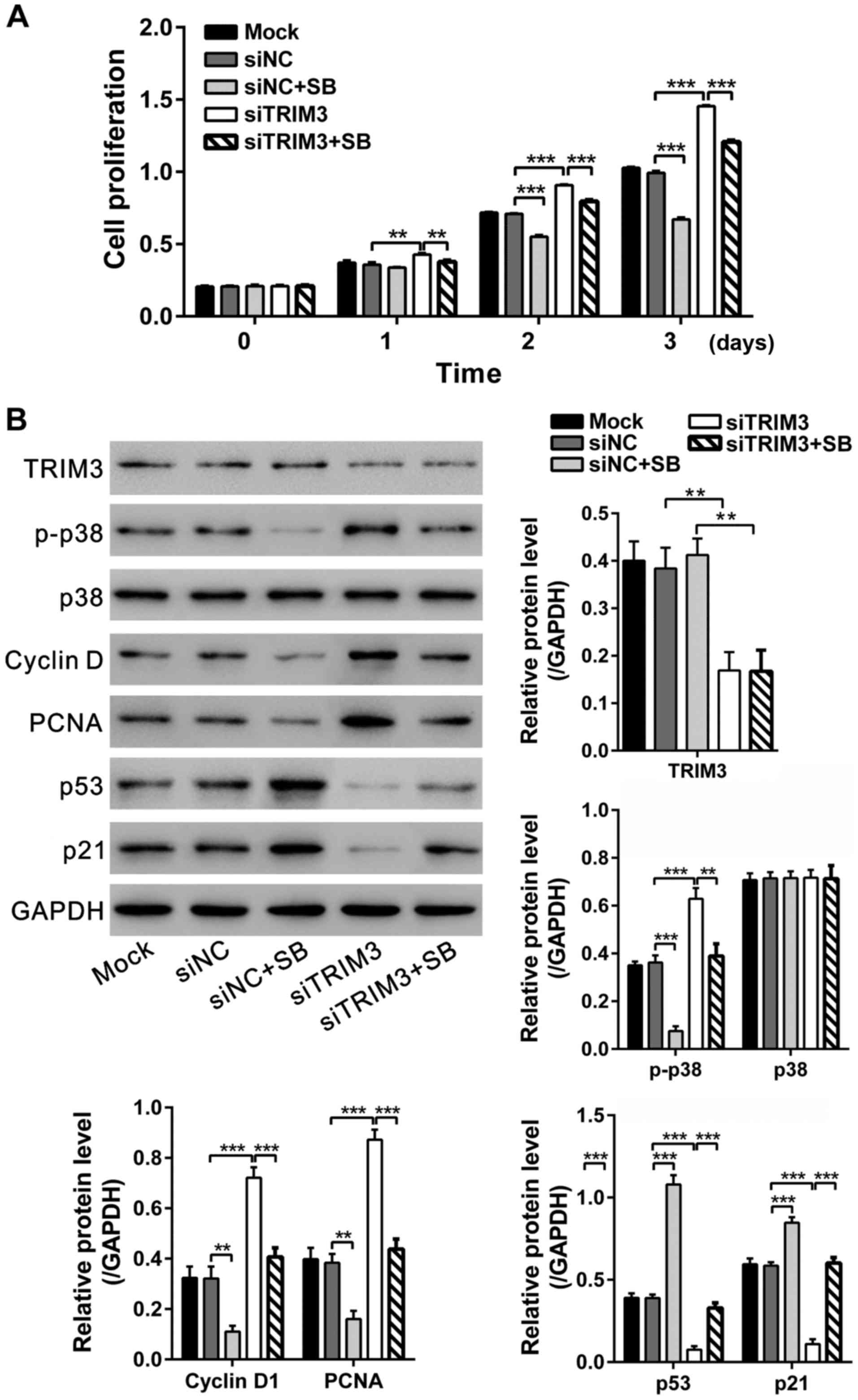The tripartite motif-containing protein 3 on the proliferation and cytokine secretion of rheumatoid arthritis fibroblast-like synoviocytes
- Authors:
- Published online on: February 2, 2017 https://doi.org/10.3892/mmr.2017.6164
- Pages: 1607-1612
-
Copyright: © Wang et al. This is an open access article distributed under the terms of Creative Commons Attribution License.
Abstract
Introduction
Rheumatoid arthritis (RA) is a chronic autoimmune disease, which primarily affects small joints of the hands and feet. The pathological characteristic of RA includes synovial hyperplasia and inflammation, pannus formation, cartilage loss and joint destruction (1). Fibroblast-like synoviocytes (FLS), a type of synovial lining cell, is considered as a pivotal effector cell in the inflamed joint. FLS exhibit high proliferation rates, constitutive expression of cytokines, and anchorage-independent cell growth (2–5). The hyperplasia of FLS leads to pannus formation and joint destruction (6). The production of cytokines, such as tumor necrosis factor (TNF)-α, interleukin (IL)-1β and IL-6, causes the erosion of cartilage and contributes to pathogenesis of RA (7).
Tripartite motif-containing protein 3 (TRIM3) belongs to TRIM proteins family, which regulates diverse biological functions including innate immune response, development and carcinogenesis (8,9). Emerging evidence has suggested that TRIM3 is a candidate tumor suppressor gene for glioblastomas (10–12) and colorectal cancer (13). Overexpression of TRIM3 inhibited cell proliferation of cancer cells (13,14). However, little is known about the expression and function of TRIM proteins, including TRIM3 in RA progression.
In the present study, we found that the mRNA and protein levels of TRIM3 were significantly decreased in RA synovial tissues. TRIM3 exerted an anti-proliferation role in primary cultured FLS from RA patients via p38 signaling pathway. Taken together, results of the current study suggest TRIM3 may be a candidate therapeutic target for RA.
Materials and methods
Tissue specimens
A total of 30 RA patients and 12 joint trauma patients (healthy control) were enrolled in this study. RA patients were diagnosed according to the American College of Rheumatology Criteria for Classification of RA (15). Written informed consent was obtained from all patients, and the study was approved by the Ethics Committee of the First Affiliated Hospital of Soochow University. Synovial tissue samples were obtained during joint replacement surgery, snap-frozen and stored at −80°C.
Real-time polymerase chain reaction (PCR)
Total RNA was isolated from collected synovial tissue samples using TRIzol (Invitrogen, Carlsbad, CA, USA) according to the manufacturers protocol. After treating with RNase-free DNase (Roche Diagnostics, Indianapolis, IN, USA) to remove any residual genomic DNA, total RNA (2 µg) was reverse-transcribed using cDNA synthesis kit (Thermo Fisher Scientific, Inc., Rockford, IL, USA). TRIM3 mRNA levels were examined by real-time PCR with SYBR-Green qPCR Master Mixes (Thermo Fisher Scientific Inc.) on an ABI 7300 cycler (Applied Biosystems, Foster City, CA, USA). Glyceraldehyde-3-phosphate dehydrogenase (GAPDH) mRNA levels were used for normalization. The primers were as follows: TRIM3, 5-GAGGGCAA GTTCAAGACCAAG-3 and 5-GGAAGGTAAAGACGC AGCAAG-3; GAPDH, 5-CACCCACTCCTCCACCTTTG-3 and 5-CCACCACCCTGTTGCTGTAG-3. TRIM3 mRNA expression was calculated using the CT method as previously described (16).
Western blot analysis
Protein were extracted from frozen tissue samples and cells by using RIPA buffer in the presence of proteinase inhibitor cocktail (Sigma, St. Louis, MO, USA). Protein concentrations were determined using the BCA kit (Thermo Fisher Scientific, Inc.). Equal amounts of protein from samples were separated on 10% SDS-PAGE and then transferred to a nitrocellulose membrane (Millipore Corp., Bedford, MA, USA). For western blot analysis, the membrane was pre-incubated with 5% skimmed milk in TBST (Tris-buffered saline containing 0.1% Tween-20) at 25°C for 1 h, and then incubated with primary antibodies overnight at 4°C. After being washed three times in TBST, horseradish peroxidase-conjugated secondary antibodies (Beyotime Institute of Biotechnology, Shanghai, China) were added and incubated for 1 h at 25°C. After three washes in TBST, hybridized bands were detected using the ECL detection kit (Millipore Corp.). The sources of primary antibodies were as follows: antibodies against TRIM3, cyclin D1, and p21 were from Abcam (Cambridge, MA, USA); antibodies to PCNA, p53, p-p38, p38 and GAPDH were from Cell Signaling Technology, Inc. (Danvers, MA, USA).
Isolation of FLS cell lines from RA patients
FLS cell lines were prepared from the synovium of RA patients as previously described (17). In brief, synovial tissues were minced into 1-mm pieces and treated with 0.4% type 1 collagenase (Sigma) and DNase in Dulbeccos modified Eagles medium (DMEM; Hyclone, Logan, UT, USA) for 2 h at 37°C in a 5% CO2-humidified incubator. Undigested tissues were removed with a cell strainer.
The dissociated cells were centrifuged at 1,000 rpm for 10 min, resuspended in DMEM supplemented with 10% fetal bovine serum (FBS; Gibco, Carlsbad, CA, USA), 100 U/ml penicillin, and 100 µg/ml streptomycin and seeded in 10-cm culture plates. Medium was replaced every 2–3 days to remove suspended cells, and cells were sub-cultured when the primary culture reached confluence. After the third passage, the cells exhibited characteristic morphology of fibroblasts and were verified by immunocytochemistry as a homogeneous population (>95% vimentin-positive and CD68-negative (5); Fig. 1). FLS at passages 4–8 were used for the experiments.
Lentivirus production and RNA interference
To create TRIM3 lentiviral expression construct, the full length human TRIM3 cDNA was inserted into pLVX-puro (Clontech Laboratories, Inc., Palo Alto, CA, USA) and verified by sequencing. pLVX-puro or pLVX-puro-TRIM3 together with viral packaging plasmids (psPAX2 and pMD2G) was transfected into HEK293T cells using Lipofectamine 2000 (Invitrogen) according to the manufacturers protocol. Vector or TRIM3 expression viral supernatant was harvested at 48 h after transfection and used to transduce FLS cell lines.
siRNA targeting human TRIM3 mRNA (5-GCUCACUG UCACUACCAAA-3) and a non-specific scramble siRNA sequence (siNC) were synthesized by GenePharma (Shanghai, China) and transfected into FLS cells using Lipofectamine 2000 (Invitrogen) according to the manufacturers instructions.
Experimental grouping
To investigate the function of TRIM3 in RA, the FLS cells were divided into three groups: group 1 (Mock), cells were cultured without any treatment; group 2, cells were infected with pLVX-puro vector virus; group 3, cells were infected with TRIM3-expressing virus. Cell Counting Kit-8 (CCK-8) assays were carried out at 0, 1, 2 and 3 days after viral infection. Western blot analysis and enzyme-linked immunosorbent assays were performed at 48 h after viral infection.
To further explore the involvement of p38 signaling, the FLS cells were divided into five groups: group 1 (Mock), cells were cultured without any treatment; group 2, cells were pretreated with DMSO for 1 h and then transfected with control siRNA (siNC); group 3, cells were pretreated with 10 µM p38 inhibitor (SB203580; Selleck Chemicals, Houston, TX, USA) for 1 h and then transfected with siNC; group 4, cells were pretreated with DMSO for 1 h and then transfected with TRIM3 siRNA (siTRIM3); group 5, cells were pre-treated with 10 µM SB203580 for 1 h and then transfected with siTRIM3. CCK-8 assays were carried out at 0, 1, 2 and 3 days after siRNA transfection. Western blot analysis was performed at 48 h after siRNA transfection.
Cell proliferation assay
FLS proliferation was determined with the CCK-8 kit (Signalway Antibody LLC (SAB), College Park, MD, USA). FLS cells (3×103/well) were plated into 96-well plates. After cultured overnight, the cells were treated as indicated and cultured at 37°C for 0, 1, 2 and 3 days. After the incubation period, the cultured media were replaced with 10% CCK-8 reagent (in DMEM), and the cells were incubated at 37°C for another 1 h. The absorbance at 450 nm was read with a microplate reader (Bio-Rad Laboratories, Inc., Hercules, CA, USA).
Immunoassays of IL-1β, IL-6 and TNF-α
The amounts of secreted cytokines in culture media were measured by ELISA. Assays were performed following the manufacturers instructions (Bio-Swamp Life Science, Shanghai, China). The absorbance was read at 450 nm and recorded on a microplate reader (Bio-Rad Laboratories, Inc.).
Statistical analysis
The results are presented as the mean ± SD. One-way analysis of variance followed by Dunnetts multiple comparisons was used for statistical analysis by GraphPad Prism 6.0 software (GraphPad, San Diego, CA, USA). P<0.05 was considered significant.
Results
TRIM3 is downregulated in synovial tissue samples of RA patients
To determine TRIM3 expression in synovial tissues, synovial tissue specimens were collected from 30 RA patients and 12 joint trauma patients (healthy control). As indicated by real-time PCR analysis, compared with healthy control, the TRIM3 mRNA in synovial tissues of RA patients decreased by 57.2% (Fig. 2A, P<0.0001). Western blot analysis also showed the downregulation of TRIM3 in RA tissues at translational level (Fig. 2B).
Inhibition of RA FLS cell proliferation by TRIM3 overexpression
Synoviocyte hyperplasia is the most prominent characteristic of RA (6). To investigate the function of TRIM3 in RA, FLS cells were isolated from the synovium of RA patients and TRIM3 was overexpressed in RA FLS cells by lentiviral transduction. CCK-8 assays showed that TRIM3 overexpressing virus (pLVX-puro-TRIM3) significantly inhibited the proliferation of RA FLS cells at 1, 2 and 3 days as compared to untreated cells (Mock) and cells transduced with vector virus (pLVX-puro) (Fig. 3A). The overexpression of TRIM3 in virally transduced cells was confirmed by western blot analysis at 48 h after lentiviral transduction (Fig. 3B).
The expression levels of cell proliferation regulators, cyclin D1, PCNA, p53 and p21, were also evaluated by western blot analysis. The levels of PCNA (a marker of cell proliferation) (18) and cyclin D1 (a cell cycle-promoting protein) (19) were downregulated, while the levels of p53 (a growth suppressor protein) (20) and its downstream target gene, p21, was upregulated by TRIM3 overexpression (Fig. 3B). These results suggested that TRIM3 inhibited the proliferation of RA FLS cells.
Suppression effect of TRIM3 on the secretion of cytokines from RA FLS
Cytokines, such as TNF-α, IL-1β and IL-6, contribute to the pathogenesis of RA (7). We next measured the changes of three cytokines in culture medium conditioned with RA FLS after overexpression of TRIM3 (Fig. 4). All cytokine levels were significantly decreased in the presence of TRIM3 overexpression.
TRIM3 inhibits the proliferation of RA FLS via p38 signaling
p38 is a key signaling component of inflammatory disease including RA (21). To further investigate the molecular mechanism through which TRIM3 inhibited the growth of RA FLS, western blot analyses were performed to study changes in p38 signaling. As shown in Fig. 5, p-p38 levels were significantly decreased at 48 h after TRIM3 expressing viral infection, while total p38 levels were unchanged.
To further explore the involvement of p38 signaling in suppression effect of TRIM3 on the proliferation of RA FLS, the p38-specific inhibitor SB203580 was added before TRIM3 siRNA transfection. Cell proliferation was repressed by SB203580 treatment, but promoted by TRIM3 knockdown. Additionally, SB203580 treatment reduced the promotion effects of TRIM3 on FLS proliferation (Fig. 6A).
The protein levels of TRIM3, p-p38, p38, cyclin D1, PCNA, p53 and p21 were then assessed by western blot analysis. As shown in Fig. 6B, SB203580 blocked the TRIM3 knockdown mediated increase of p-p38, cyclin D1 and PCNA, and rescued the TRIM3 knockdown mediated decrease of p53 and p21. Collectively, these results support the hypothesis that the suppression effects of TRIM3 on RA FLS proliferation may be achieved via inactivating p38 signaling.
Discussion
In the present study, we show that the expression of TRIM3 was significantly lower in RA synovial tissues than in control tissues. Overexpression of TRIM3 in RA FLS led to decreased cell proliferation and reduced production of TNF-α, IL-1β and IL-6. The suppression effects of cell proliferation by TRIM3 were partially mediated via impaired p38 signaling.
Pathologic expression of TRIM3 has been identified in glioblastomas (10–12), colorectal cancer (13) and hepatocellular carcinoma, where its expression levels are lower than in normal tissues. TRIM3 functions as a tumor suppressor (10–13). Studies of cancer cells have also shown that TRIM3 overexpression can inhibit cell proliferation (13,14). The present results of CCK-8 and western blot (PCNA and cyclin D1) analyses in RA FLS were in accordance with previous findings.
It has been reported that RA synovium expressed many cytokines (22). Among these cytokines, IL-1β, IL-6 and TNF-α are critical in the evolution of RA, partly because anti-cytokine strategies have been successfully applied for patients (23,24). Several members of TRIMs, such as TRIM30α, TRIM8 and TRIM21, are involved in the innate immunity response (8). The current study revealed that TRIM3 overexpression can inhibit the secretion of IL-1β, IL-6 and TNF-α, indicating the role of TRIM3 in inflammatory response and the potential clinical application of TRIM3 in RA.
Overexpression of TRIM3 in colorectal cancer cells is able to upregulate p53 with concomitant induction of downstream target genes, p21 and GADD45 (13). p38, a cell proliferation regulator, is a key signaling component of inflammatory disease including RA (21). Chemotherapeutic agents can activate p53 via p38 signaling (25). Here, TRIM3 overexpression decreased the expression of p53, p21 and p-p38 in RA FLS. By using the p38-specific inhibitor SB203580, we found that the effects of TRIM3 on p53 was dependent on p38 activity. SB203580 blocked the effects of TRIM3 knockdown that increased cell proliferation, and enhanced the expression of cyclin D1 and PCNA. Therefore, the collective evidence indicated that TRIM3 may inactivate p38/p53 signaling pathway and could serve as a potential therapeutic target.
In conclusion, our findings demonstrated that TRIM3 expression was downregulated in RA synovium. It inhibited RA FLS proliferation via p38 signaling pathway, and suppressed cytokine secretion. Thus, TRIM3 plays a potentially protective role for FLS hyperplasia and inflammation.
References
|
Majithia V and Geraci SA: Rheumatoid arthritis: Diagnosis and management. Am J Med. 120:936–939. 2007. View Article : Google Scholar : PubMed/NCBI | |
|
Ritchlin C, Dwyer E, Bucala R and Winchester R: Sustained and distinctive patterns of gene activation in synovial fibroblasts and whole synovial tissue obtained from inflammatory synovitis. Scand J Immunol. 40:292–298. 1994. View Article : Google Scholar : PubMed/NCBI | |
|
Bucala R, Ritchlin C, Winchester R and Cerami A: Constitutive production of inflammatory and mitogenic cytokines by rheumatoid synovial fibroblasts. J Exp Med. 173:569–574. 1991. View Article : Google Scholar : PubMed/NCBI | |
|
Lafyatis R, Remmers EF, Roberts AB, Yocum DE, Sporn MB and Wilder RL: Anchorage-independent growth of synoviocytes from arthritic and normal joints. Stimulation by exogenous platelet-derived growth factor and inhibition by transforming growth factor-beta and retinoids. J Clin Invest. 83:1267–1276. 1989. View Article : Google Scholar : PubMed/NCBI | |
|
Bartok B and Firestein GS: Fibroblast-like synoviocytes: Key effector cells in rheumatoid arthritis. Immunol Rev. 233:233–255. 2010. View Article : Google Scholar : PubMed/NCBI | |
|
Wicks I, Cooley H and Szer J: Autologous hemopoietic stem cell transplantation: A possible cure for rheumatoid arthritis? Arthritis Rheum. 40:1005–1011. 1997. View Article : Google Scholar : PubMed/NCBI | |
|
Firestein GS: Invasive fibroblast-like synoviocytes in rheumatoid arthritis. Passive responders or transformed aggressors? Arthritis Rheum. 39:1781–1790. 1996. View Article : Google Scholar : PubMed/NCBI | |
|
Ozato K, Shin DM, Chang TH and Morse HC 3rd: TRIM family proteins and their emerging roles in innate immunity. Nat Rev Immunol. 8:849–860. 2008. View Article : Google Scholar : PubMed/NCBI | |
|
Hatakeyama S: TRIM proteins and cancer. Nat Rev Cancer. 11:792–804. 2011. View Article : Google Scholar : PubMed/NCBI | |
|
Liu Y, Raheja R, Yeh N, Ciznadija D, Pedraza AM, Ozawa T, Hukkelhoven E, Erdjument-Bromage H, Tempst P, Gauthier NP, et al: TRIM3, a tumor suppressor linked to regulation of p21Waf1/Cip1. Oncogene. 33:308–315. 2014. View Article : Google Scholar : PubMed/NCBI | |
|
Chen G, Kong J, Tucker-Burden C, Anand M, Rong Y, Rahman F, Moreno CS, Van Meir EG, Hadjipanayis CG and Brat DJ: Human Brat ortholog TRIM3 is a tumor suppressor that regulates asymmetric cell division in glioblastoma. Cancer Res. 74:4536–4548. 2014. View Article : Google Scholar : PubMed/NCBI | |
|
Boulay JL, Stiefel U, Taylor E, Dolder B, Merlo A and Hirth F: Loss of heterozygosity of TRIM3 in malignant gliomas. BMC Cancer. 9:712009. View Article : Google Scholar : PubMed/NCBI | |
|
Piao MY, Cao HL, He NN, Xu MQ, Dong WX, Wang WQ, Wang BM and Zhou B: Potential role of TRIM3 as a novel tumour suppressor in colorectal cancer (CRC) development. Scand J Gastroenterol. 51:572–582. 2016. View Article : Google Scholar : PubMed/NCBI | |
|
Raheja R, Liu Y, Hukkelhoven E, Yeh N and Koff A: The ability of TRIM3 to induce growth arrest depends on RING-dependent E3 ligase activity. Biochem J. 458:537–545. 2014. View Article : Google Scholar : PubMed/NCBI | |
|
Cohen S and Emery P: The American College of Rheumatology/European League Against Rheumatism criteria for the classification of rheumatoid arthritis: A game changer. Arthritis Rheum. 62:2592–2594. 2010. View Article : Google Scholar : PubMed/NCBI | |
|
Saha SK, Roy S and Khuda-Bukhsh AR: Ultra-highly diluted plant extracts of Hydrastis canadensis and Marsdenia condurango induce epigenetic modifications and alter gene expression profiles in HeLa cells in vitro. J Integr Med. 13:400–411. 2015. View Article : Google Scholar : PubMed/NCBI | |
|
Nishida K, Komiyama T, Miyazawa S, Shen ZN, Furumatsu T, Doi H, Yoshida A, Yamana J, Yamamura M, Ninomiya Y, et al: Histone deacetylase inhibitor suppression of autoantibody-mediated arthritis in mice via regulation of p16INK4a and p21WAF1/Cip1 expression. Arthritis Rheum. 50:3365–3376. 2004. View Article : Google Scholar : PubMed/NCBI | |
|
Robbins BA, de la Vega D, Ogata K, Tan EM and Nakamura RM: Immunohistochemical detection of proliferating cell nuclear antigen in solid human malignancies. Arch Pathol Lab Med. 111:841–845. 1987.PubMed/NCBI | |
|
Fu M, Wang C, Li Z, Sakamaki T and Pestell RG: Minireview: Cyclin D1: Normal and abnormal functions. Endocrinology. 145:5439–5447. 2004. View Article : Google Scholar : PubMed/NCBI | |
|
Montenarh M: Functional implications of the growth-suppressor oncoprotein p53 (Review). Int J Oncol. 1:37–45. 1992.PubMed/NCBI | |
|
Pargellis C and Regan J: Inhibitors of p38 mitogen-activated protein kinase for the treatment of rheumatoid arthritis (Review). Curr Opin Investig Drugs. 4:566–571. 2003.PubMed/NCBI | |
|
McInnes IB and Schett G: Cytokines in the pathogenesis of rheumatoid arthritis. Nat Rev Immunol. 7:429–442. 2007. View Article : Google Scholar : PubMed/NCBI | |
|
Nishimoto N, Hashimoto J, Miyasaka N, Yamamoto K, Kawai S, Takeuchi T, Murata N, van der Heijde D and Kishimoto T: Study of active controlled monotherapy used for rheumatoid arthritis, an IL-6 inhibitor (SAMURAI): Evidence of clinical and radiographic benefit from an × ray reader-blinded randomised controlled trial of tocilizumab. Ann Rheum Dis. 66:1162–1167. 2007. View Article : Google Scholar : PubMed/NCBI | |
|
Maini RN and Taylor PC: Anti-cytokine therapy for rheumatoid arthritis. Annu Rev Med. 51:207–229. 2000. View Article : Google Scholar : PubMed/NCBI | |
|
Sanchez-Prieto R, Rojas JM, Taya Y and Gutkind JS: A role for the p38 mitogen-acitvated protein kinase pathway in the transcriptional activation of p53 on genotoxic stress by chemotherapeutic agents. Cancer Res. 60:2464–2472. 2000.PubMed/NCBI |















